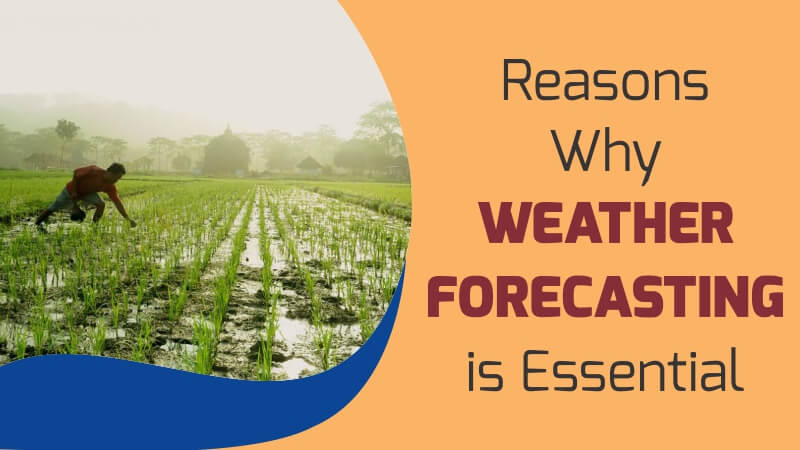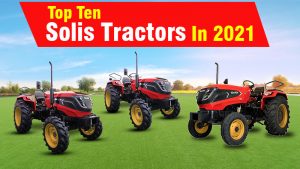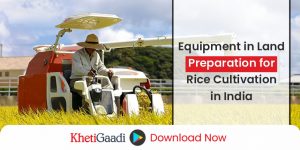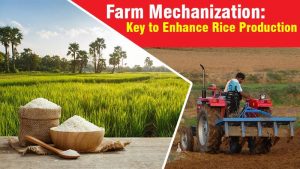Weather forecasting aids in forecasting future climate conditions, climatology is crucial. The likelihood that snow and hail will reach the surface can be calculated using latitude. Through weather forecasting, you may also determine the thermal energy from the sun that a location will get. The average weather over a period of time is referred to as a climate, and climatology is the scientific study of climates.
The majority of people are aware of how weather significantly affects the agriculture sector. Indeed, for crops to thrive, they require the fundamentals of moisture, warmth, and sunlight. What is less clear, however, is how a grower’s business decisions can be influenced by the specifics of weather information, enabling them to plan effectively, save expenses, and increase yields and profits as a result.
What is weather forecasting?
It is a science of knowing what will be the atmospheric or weather conditions likely to occur at a specific location at a specific time. Weather forecasting is the process of predicting the weather conditions that will exist at a specific location and time with a certain probability. This is accomplished with the use of a powerful computer and weather modeling. In other words, it allows for the early prediction of events like cloud cover, rain, snow, wind speed, and temperature.
Role of weather forecasting in Agriculture:
Since the beginning of time, the Indian province has made weather predictions. The basis for ancient weather forecasting was the study of weather patterns, primarily the type of wind and the shape and color of the clouds. In folklore statements from medieval India, observations of weather patterns have been undertaken over time for a variety of purposes. Numerical weather models and statistical tools for quantitative forecasting at various time scales are used in modern weather forecasting. These models generated district-level quantitative weather forecasts for the next 5-7 days and made them available to Indian farmers. There are three primary methods for predicting the weather: synoptic (also known as conventional), statistical (empirical), and numerical.
By utilizing any of the three methods mentioned above, either separately or in combination, it is possible to create qualitative or quantitative weather forecasts over various time scales. The numerical technique can thoroughly take into account all aspects, physical and dynamical, significant to weather development, in contrast to the synoptic and statistical approaches, which rely on the examination of a small number of parameters or features.
Farmers’ success is based on weather monitoring
Weather and crop growth are tightly intertwined. Some crops must germinate and develop at specific high or low temperatures in order to begin. On the other hand, temperatures and humidity are frequently utilized to forecast the occurrence of certain insect pests and diseases. Farmers can schedule schedules for planting, protection, harvesting, and other field activities based on this information to prevent adverse weather conditions and yield losses is the single variable that affects crop production. Every field’s weather observations are included to provide data on the present crop-growing environment.
A farmer’s business decisions may benefit from the use of weather forecasts. They can better prepare for the numerous daily decisions by using forecasts. These choices include when to fertilize when irrigating crops, and which days are best for fieldwork. Farmers’ choices will determine whether or not their crop is lucrative.
A farmer must be mindful of the moisture, light, and temperature in order to grow a successful crop. It is necessary to have access to comprehensive weather data, including historical records, current weather, and future forecasts. The cost of the crop is determined by a number of choices. For instance, if rain is predicted, a farmer can save water and money by forgoing irrigation.
In order to provide meaningful data on soil and crop conditions, weather monitoring offers a variety of measurement alternatives, some of which are:
- The temperature of the soil and the atmosphere
- Humidity relative
- Soil hydration
- Rainfall
- Wind direction and speed
- Evapotranspiration
All measured factors can be applied to specific field tasks like scheduling irrigation events, creating insect alarm models, and figuring out when to fertilize and protect crops. Weather-based farming is essential to effective farm management. It also ensures sustainable farming, which safeguards the environment.
How does wind forecasting work?
Knowing when to apply fertilizer, how much to apply, and what kind of fertilizer to use are crucial skills for farmers. The revenues from the field could be lost due to bad weather at the time of application. The soil must be damp enough to let the fertilizer penetrate, but dry enough to prevent the fertilizer from washing away.
Temperature and soil moisture both have a role in this. Farmers can schedule their daily operations more effectively by using accurate weather information.
The application of pest control agents depends in large part on wind forecasts. The weather can have an impact on pests that destroy crops. When to use pest controls can be decided with some guidance in this. When wind conditions won’t cause sprayed chemicals to miss their targets, crop dusters should only be used to spray fungicidal or insecticidal chemicals on plants from above.
What is satellite Forecasting?
The advantages of satellite weather forecasting are its global reporting, accuracy, and high resolution. It is also capable of making lengthy weather predictions. Because of its many benefits, farmers will rely on satellite forecasting more often than usual in the future.
In order to help with the best farming conditions, agricultural weather stations are devices that measure and show various local measurements. You can view this information on-site or online. The majority of weather stations detect solar radiation, pressure, temperature, humidity, wind speed, and direction. Additionally, measurements for the UV index, soil moisture and temperature, leaf wetness, and water temperature will all be included in some sophisticated models.
Where to know weather forecasting?
The weather stations for farming can be equipped with extra sensors to help in farming. Depending on the type of crops, soil and UV index sensors might be very beneficial to a farmer even though humidity, rainfall, and temperature sensors are necessary. Software that enables more proficient analysis of weather and soil data is included with a decent weather station for farmers. This kind of weather station compares seasonal weather conditions locally to historical weather data so that farmers can make well-informed judgments.
An anemometer, which measures wind speed, and a wind vane, which measures wind direction, are common components found in weather stations. It will have a GPS antenna and a satellite. Pyranometers are used to measure solar radiation. These stations will have a temperature sensor, a thermometer that is shielded from the sun, and a relative humidity sensor that is an electronic capacitive sensor. They will have a solar panel inside to run the weather station automatically. A rain gauge will be used to gauge the amount of rain. To store the energy from the sun, batteries are provided.
KhetiGuru provides you with all detailed information about farming methods, and other agricultural activities. To know complete details about farming install the Khetiguru application. For tractor, tractor price, tractor news, and all the latest updates install the KhetiGaadi application.




